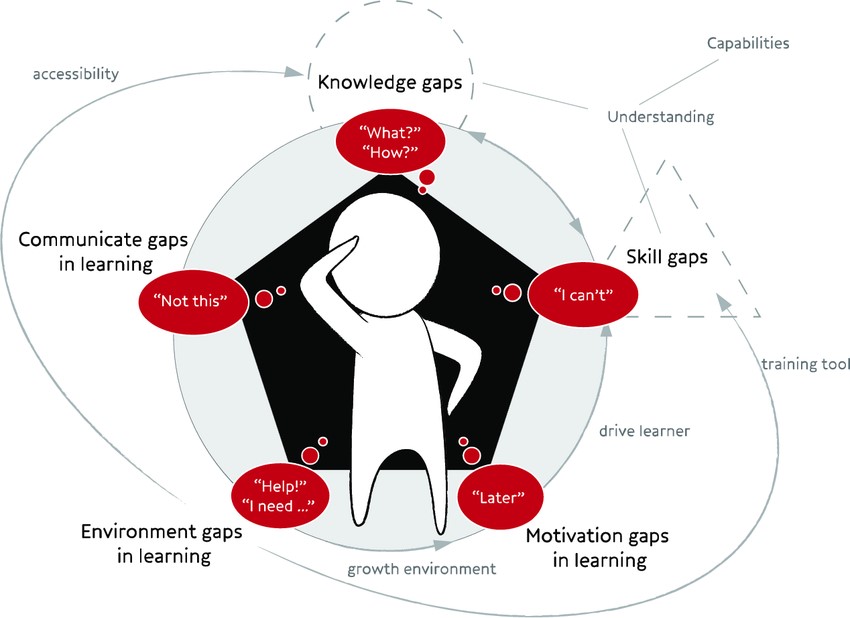Decoding Student Struggles: A Teacher's Guide to Identifying and Addressing Learning Gaps
18th March 2024

It’s every teacher’s responsibility to understand the different learning needs of their students to ensure their academic success. One of the important aspects of students which every teacher should focus on is learning gaps.
By identifying learning gaps, educators can come up with effective strategies to address those learning gaps to provide the required support assistance to every student.
If you also have the ambition to understand your student’s learning gap and help them to overcome it, then we got you covered.
In this blog post, we will be exploring different types of learning gaps, their causes, and how you can address those learning gaps in students successfully.
Before moving to the topic, can we ask you a question? Do you follow us on Social Media? We regularly share upgraded educational content, tips, feedback, and more. Check us out by clicking the profiles here - Facebook / Twitter / LinkedIn / Pinterest / Instagram / YouTube
So, without any further delay, let’s get started.
What is Learning Gaps?
Learning Gaps also known as “Educational Gaps” or “Knowledge Gaps” simply means that students have inconsistent comprehension and proficiency in a particular subject or skill. These gaps occur when students not being able to grasp the concept of any topic retain information, or lack the required skills to achieve good grades or for academic progress. The root cause of learning gaps in students can be-
- Different learning style
- Differences in prior education
- Difficulty in understanding the teacher’s instruction
- Distractions
- Due to any personal circumstances.
5 Types of Learning Gaps

Learning gaps has many types, each form negatively impacts the student’s academic progress in a different manner. Let’s get to know those types in detail-
Knowledge Gaps
Knowledge gaps exist in students when they need further in-depth understanding of any particular subject’s topic. For example- a student might have a knowledge of the subject history because he might not be familiar with significant historical events and their causes like- World War I, and II.
Skill Gaps
Skill gaps generally occur when a student lacks the required skills to complete a particular task. For example- Student might not be able to structure their thoughts, construct the right paragraph, or use the right pronunciation or grammar while writing.
Motivation Gaps
Motivation Gaps occurs when students lack the required motivation to complete their tasks or assignments. For example: Students might not have any sort of interest in Mathematics subject and don’t like to spend time solving any numerical problems.
Environmental Gaps
Environment Gaps occur when students come from a lower or disadvantaged background. They generally lack quality education resources and tools such as- books, notebooks, or technological gadgets like- smartphones, which ultimately become an obstacle in their learning journey.
Communication Gaps
Communication Gaps occur when students have a hard time in their language learning and struggle to read, write, and express themselves properly. They also face difficulty in understanding the educator’s instruction which makes their language acquisition experience more difficult.
How To Recognize Your Student’s Learning Gaps?
Identifying learning gaps is essential to provide the required support and assistance to student for their improvement in their academic growth. Let’s get to know various ways to identify learning gaps in students-
- Formative Assessment
You can consider conducting formative assessments on a regular basis to keep a check on where students are struggling and have scope for improvement. Conduct Assessments such as- quizzes, short assignments based on taught lessons, polls, etc. to gauge student’s understanding related to any topics.
- Observe Their Progress
Observer your students carefully during classroom activities, discussions, and assignments. See how much they are engaging, participating in any discussion, and how they are responding to any questions. Lack of participation and giving incorrect answers simply refers to students dealing with learning gaps.
- Classwork and Homework Analysis
Consider reviewing every student’s class performance and their homework performance whether they are error-free or they are having any misunderstanding or not. If they give wrong answers or have misconceptions then it shows students have learning gaps.
- Standardized Tests
With the help of standardized tests and assessments, you can gauge student’s performance according to state board standards. This will help you to check the broader gap in the curriculum.
- Effective Curriculum Planning
You can consider analysing your curriculum and learning objectives to figure out where students might be facing challenges. To identify learning gaps, you can cross-reference with students.
Learn to connect with your student’s better, here:
5 Effective Tips To Overcome Learning Gaps
Encourage Students To Ask For Help
As a responsible educator, you must strive for a positive and encouraging learning environment where student can ask their doubts freely without any fear of judgment and as many times as they want to.
Make them understand that every student has their own learning pace and it’s completely okay for you if you need extra time to understand any subject or topic.
Build Genuine Connection
Try to build genuine connections on an individual level with every student to understand their learning needs and personal interests, aspirations, and hobbies. After knowing your student’s interests, try to include their interest and experiences in your lesson, which will create an engaging learning environment. This will encourage students to actively participate in class and improve their learning gaps.
Leverage Technology
Consider integrating technology into your teaching method to improve the learning experience for your students. You can use various educational apps, and online resources which help to create a personalized learning experience for students and it also gives you the opportunity to track their progress and figure out their learning gaps. This will help you to create effective strategies to help students to overcome their learning gaps.
Check-in Regularly
Consider check-in regularly your students’ learning progress to figure out their learning gaps. By doing so, you will prevent those learning gaps to get widened further. You can use formal assessments like- quizzes, polls, and informal assessments like- classroom discussions, exit tickets, etc. This will help you to gain insights into every student’s understanding level and also help you to identify any scope for improvement.
Invest in Your Professional Development
Consider investing in professional development to stay updated with the latest teaching methods, strategies, and assessment techniques which will help to figure out learning gaps in students more effectively. Attend seminars, workshops, or events where you can meet with other experts in the educational industry who can help you come up with more effective strategies to help your students with learning gaps.
Bridging The Learning Gaps Is The Key For Student’s Success
Students can go through various learning gaps which may become a hindrance in their academic journey. However, as a responsible educator, you must be able to recognize the learning gaps and must help them to overcome them. You can go through the above-mentioned tips to help your students overcome their learning gaps and help them march toward academic success.
To become a more effective educator and to stay up-to-date with all the latest teaching methods, strategies, and assessment techniques you should consider pursuing courses like Integrated Master’s and Professional Doctorate in Education, where you will get guidance from top expert trainers and help you to become an effective educator.
We believe education should be accessible for everyone. That’s why we don’t charge for our blogs. Find the right course that will help you in your career with us, contact us at - 1800–212–6400. You can mail us at act@asiancollegeofteachers.com
